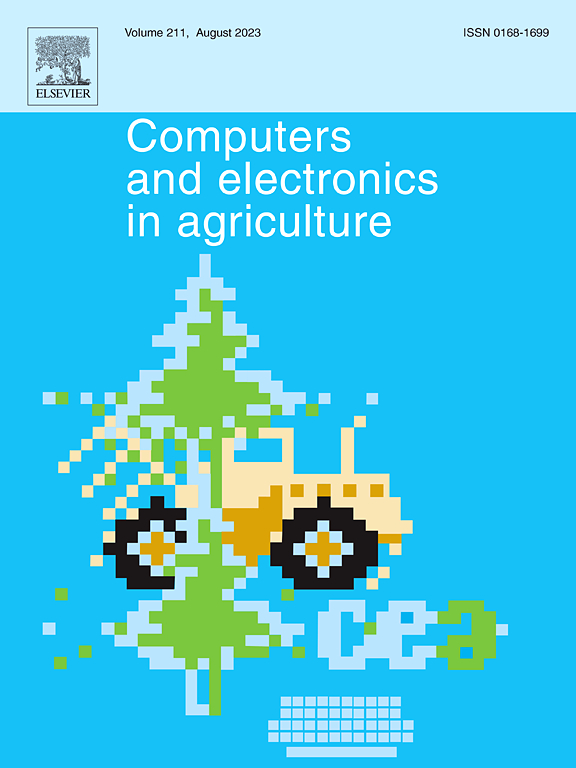半监督杂草检测,快速部署和提高效率
IF 8.9
1区 农林科学
Q1 AGRICULTURE, MULTIDISCIPLINARY
引用次数: 0
摘要
杂草给农业带来了重大挑战,造成产量损失,需要昂贵的控制措施。使用计算机视觉和深度学习的自动杂草检测提供了一个很有前途的解决方案。然而,传统的深度学习方法通常需要大量标记的训练数据,而这些数据的获取既昂贵又耗时。本文介绍了一种新的半监督杂草检测方法——半监督多尺度检测器(semi-supervised Multi-Scale Detector, SSMD)。首先,采用多尺度特征表示技术捕获不同尺度的杂草特征;其次,研究提出了一种自适应伪标签分配策略,在训练过程中利用一小组标记图像。该策略动态地为从未标记数据生成的伪标签分配置信度分数。此外,该方法结合了时代对应和混合伪标签,进一步提高了学习过程。在COCO数据集和五个著名的杂草数据集(CottonWeedDet12、CropAndWeed、Palmer amaranth、RadishWheat和RoboWeedMap)上的实验结果表明,即使与现有技术相比,标记数据明显减少,所提出的SSMD在杂草检测方面也达到了最先进的性能。这种SSMD有可能减轻标签负担,提高深度学习在现实农业场景中用于杂草检测的可行性和部署速度。提出的SSMD的贡献包括:(1)减少标记负担:提出的方法显著减少了对大量标记数据的需求,使深度学习模型在实际部署中更加实用和经济。(2)提高杂草检测性能:实验表明,该方法在有限的标记数据下实现了最先进的杂草检测性能。(3)提高杂草管理效率:该方法提高了效率和准确性,在农业应用中可以更好地管理资源,减少对环境的影响。本文章由计算机程序翻译,如有差异,请以英文原文为准。
Semi-supervised weed detection for rapid deployment and enhanced efficiency
Weeds present a significant challenge in agriculture, causing yield loss and requiring expensive control measures. Automatic weed detection using computer vision and deep learning offers a promising solution. However, conventional deep learning methods often require large amounts of labeled training data, which can be costly and time-consuming to acquire. This paper introduces a novel method for semi-supervised weed detection, Semi-Supervised Multi-Scale Detector (SSMD), comprising two main components. Firstly, a multi-scale feature representation technique is employed to capture distinctive weed features across different scales. Secondly, the study proposes an adaptive pseudo-label assignment strategy, leveraging a small set of labeled images during training. This strategy dynamically assigns confidence scores to pseudo-labels generated from unlabeled data. Additionally, the proposed approach integrates epoch-corresponding and mixed pseudo-labels to further enhance the learning process. Experimental results on the COCO dataset and five prominent weed datasets, CottonWeedDet12, CropAndWeed, Palmer amaranth, RadishWheat, and RoboWeedMap, illustrate that the proposed SSMD achieves state-of-the-art performance in weed detection, even with significantly less labeled data compared to existing techniques. This SSMD holds the potential to alleviate the labeling burden and enhance the feasibility and deployment speed of deep learning for weed detection in real-world agricultural scenarios. The contributions of the proposed SSMD include: (1) Reduced Labeling Burden: The proposed approach significantly reduces the need for large amounts of labeled data, making deep learning models more practical and cost-effective for real-world deployments. (2) Improved Weed Detection Performance: Experiments demonstrate that the proposed method achieves state-of-the-art performance in weed detection with limited labeled data. (3) Enhanced Efficiency for Weed Management: The proposed method offers improved efficiency and accuracy, leading to better resource management and reduced environmental impact in agricultural applications.
求助全文
通过发布文献求助,成功后即可免费获取论文全文。
去求助
来源期刊

Computers and Electronics in Agriculture
工程技术-计算机:跨学科应用
CiteScore
15.30
自引率
14.50%
发文量
800
审稿时长
62 days
期刊介绍:
Computers and Electronics in Agriculture provides international coverage of advancements in computer hardware, software, electronic instrumentation, and control systems applied to agricultural challenges. Encompassing agronomy, horticulture, forestry, aquaculture, and animal farming, the journal publishes original papers, reviews, and applications notes. It explores the use of computers and electronics in plant or animal agricultural production, covering topics like agricultural soils, water, pests, controlled environments, and waste. The scope extends to on-farm post-harvest operations and relevant technologies, including artificial intelligence, sensors, machine vision, robotics, networking, and simulation modeling. Its companion journal, Smart Agricultural Technology, continues the focus on smart applications in production agriculture.
 求助内容:
求助内容: 应助结果提醒方式:
应助结果提醒方式:


